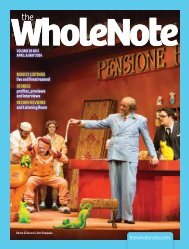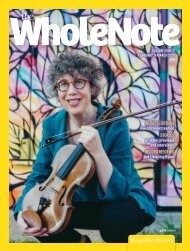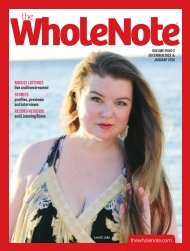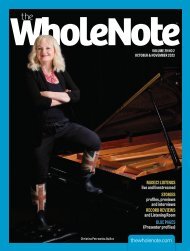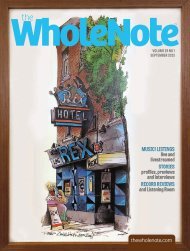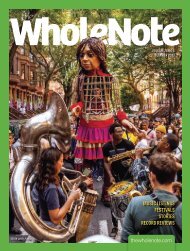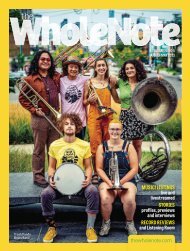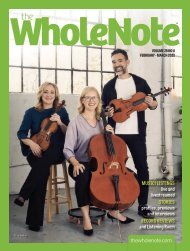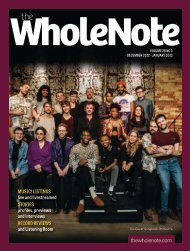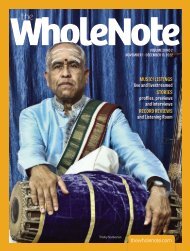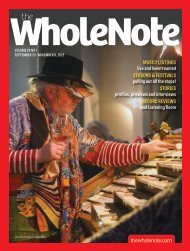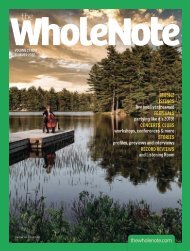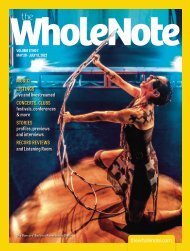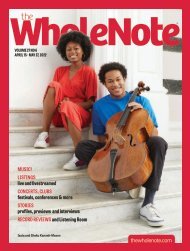You also want an ePaper? Increase the reach of your titles
YUMPU automatically turns print PDFs into web optimized ePapers that Google loves.
EDITOR’S CORNER continued …became the second laureate of the GlennGould Prize, awarded every three years bythe Glenn Gould Foundation in recognitionof outstanding achievements in music andcommunication. This year the ninth iterationof the prize will be bestowed on LeonardCohen at a concert at Massey Hall on <strong>May</strong> 14featuring a veritable “Who’s Who” of thepop world which has been so influenced byCohen’s output over the past half century.The announcement of the award promptedme to revisit a DVD that was issued in 2010of a film by Tony Palmer entitledLeonard Cohen – Bird on a Wire(TPDVD166). This documentarywas shot during Cohen’s 1972European tour which also tookhim to Tel Aviv and Jerusalem. Ifound it very interesting to hearthe then 37 year old singer talkingabout how some of the songswere written 10 and 15 yearspreviously and how hard it wasto continue to relate to them somany years later. I wonder what hisperspective is now, 40 moreyears on. The film is verycandid and we see some lessthan winning sides of the artist,baiting stage (state) securityforces at a concert in Tel Aviv,petulantly refusing to return tothe stage on a night when he feelsthere is no magic in the performanceand demeaning (while seemingto reason with) disappointedfans after a concert in Berlin. Itis a surprising portrait in manyways, of a successful artist inmid-career, warts and all.The most surprising aspect ofthis film to me was the realizationthat so many of the iconicsongs that we know Leonard Cohen for,Hallelujah and First We Take Manhattannotwithstanding, were written as a youngman and, perhaps more surprising, that thevoice we never considered “good” was actuallyquite musical in those early years.Of course Cohen has had a long and successfulcareer and in recent years has continuedto release albums and tour extensively.The 2008 documentary Live in London and atribute concert at the Montreal Jazz Festivalthat year are testament to his ongoing influencein the music world. Most recently OldIdeas (Columbia 88697986712) has beenvery well received although this critic willreserve judgement on the recent output untilcover versions of the songs begin to appear.Evidently there have been 150 renditions ofHallelujah, in many different languages andgenres, but I have my doubts that the newAmen will achieve such glory.Another Glenn Gould Prize laureatewho has caught my attention this month isPierre Boulez who won the $50,000 awardin 2002. A new recording of Mémoriale andDérive 1 & 2 featuring Ensemble OrchestralContemporain under founder Daniel Kawra(naïve MO 782183) presents interrelatedworks from the mid-1980s. The last of thesehas continued to occupy Boulez since itsconception with the most recent revisiondating from 2006; the first is based on amovement from the 1972 work … explosantefixe… written in response to the death ofStravinsky. So in effect the pieces herereflect three and a half decades of Boulez’compositional output.The disc seems organic in the way it progresses.It begins with Mémoriale for soloflute, two horns, three violins,two violas and cello, dedicatedto the memory of Canadian flutistLawrence Beauregard whoworked closely with Boulez inthe development of interactivecomputer/instrument interfacesat IRCAM, Mémoriale exists intwo versions: with and withouttechnology. I had to listen verycarefully to this recording torealize that this is the purelyacoustic rendition. The stringsusing metal practise mutes producean ethereal shimmering thatsounds almost electronic.Although composed in 1984,a year earlier than Mémoriale,Dérive 1 seems to grow outof the opening piece. Onlythis time the strings are notmuted and it is as if familiar materialhas been amplified, orrather magnified.This is taken a step furtherin the 50 minute Dérive 2. Iwas surprised to realize that althoughusing a much larger ensemblethan the opening pieces,the orchestration here involvesjust 16 players. My initial impressionwas of a concerto for orchestra butthe basic one per part instrumentation producesa deceptively full spectrum of sound.The addition of harp, piano, vibraphone andmarimba to the bare bones ensemble contributesto the effect. I found the bassoon,English horn and clarinet cadenzas especiallyintriguing.This recording will provide a good introductionto the music of one of the most importantcomposers of our time for those notyet familiar with Boulez. It is also an importantaddition to the discography for those whoalready realize the scope of this master.We welcome your feedback and invitesubmissions. CDs and comments should besent to: The WholeNote, 503–720 BathurstSt., Toronto ON M5S 2R4. We also encourageyou to visit our website www.thewholenote.comwhere you can find added featuresincluding direct links to performers, composersand record labels, “buy buttons” foronline shopping and additional, expandedand archival reviews.—David Olds, DISCoveries Editordiscoveries@thewholenote.comVOCALBach – St. John PassionChoir of King’s College,Cambridge;Stephen CleoburyBrilliant Classics 94316Bach – St. John PassionBach Choir of Bethlehem; Bach FestivalOrchestra; Greg FunfgeldAnalekta AN 2 9890-1J.S. Bach’ssacred works forsoloists, choir andorchestra are allmind-bogglinglywonderful, so to beappointed the taskof considering thesetwo excellent performancesof his St.John Passion wasa true Easter treat.The first is a new releasefrom the BachChoir of Bethlehem(Pennsylvania), thesecond a re-issueof a 1995 releasefeaturing the Choir of King’s College,Cambridge. Both choirs have a venerable history:the Bethlehem group was the first BachChoir founded in the USA (in 1891) andgave that country’s premiere performance ofBach’s B Minor Mass in 1900; and the Choirof King’s College, Cambridge, has beenone of England’s premiere choral groups foreons. The BCB is partnered in this recordingproject by their own Bach Festival Orchestra,playing on modern instruments, while theCKCC is accompanied by the BrandenburgConsort on period instruments.The soloists on both recordings are alloutstanding. Though all the wonderful singersin the CKCC reissue are now no longeron the regular soloist “circuit,” the combinedcast listings read like a partial “Who’s Who”of the baroque scene. Of special note in the<strong>May</strong> 1 – June 7, <strong>2012</strong>thewholenote.com 61





